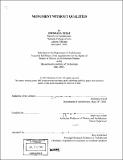Monument without qualities
Author(s)
Yusaf, Shundana, 1970-
DownloadFull printable version (21.28Mb)
Other Contributors
Massachusetts Institute of Technology. Dept. of Architecture.
Advisor
Mark Jarzombek.
Terms of use
Metadata
Show full item recordAbstract
Traditional interpretations of monuments look either at the process of production or of the nature of reception. In this thesis, I take a slightly different approach and look at the monument that exists in peoples' imagination prior to what is actually constructed. The mausoleum of Quaid-e-Azam Mohammed Ali Jinnah, the founding leader of Pakistan, provides an appropriate subject for such an approach. Jinnah was a larger than life figure, who embodied for most of the citizens of the new nation the ideals on which the country was founded. The imagination of his mausoleum is therefore intertwined in very dense ways with the popular imagination of identity, nationhood, and national ideals. Another reason for favoring this approach is the availability of direct information on popular conceptions of the proposed monument. These conceptions were recorded in a series of letters written by ordinary people to Miss Fatima Jinnah, the sister of Mohammed Ali Jinnah, and by most accounts the protector of his idealistic legacy. This mode of inquiry raises a number of theoretical issues. One is the articulation in these correspondences, of the appropriation of the ideal of. the monument in a moment before it is built. It problemitizes the entanglement of the monument with what de Certeau calls 'strategies of power' and 'tactics of below' by illuminating facets of the nature of each. Behind this lies a fundamental question. How does one gain access to and think about a modern monument in order to be able to understand its nature and to narrate its story? I use content of these letters to approach this question.
Description
Thesis (S.M.)--Massachusetts Institute of Technology, Dept. of Architecture, 2001. Includes bibliographical references.
Date issued
2001Department
Massachusetts Institute of Technology. Department of ArchitecturePublisher
Massachusetts Institute of Technology
Keywords
Architecture.